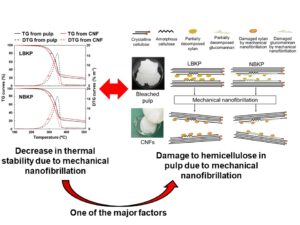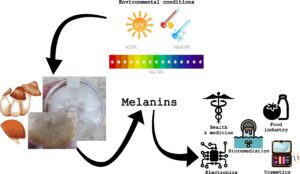Volume 18 Issue 4
Latest articles
- Researchpp 8573-8584Hideno, A. (2023). “Thermal-degradation characteristics of mechanically nanofibrillated bleached pulps from hardwood and softwood,” BioResources 18(4), 8573-8584.AbstractArticlePDF

Nanofibrillated cellulose (NFC) consists of ultrafine cellulose structures in which the fibrils can have widths in the range from about 5 to 100 nm. NFC has been studied and developed in the paper industry, using bleached pulp from wood as the raw material. One of the issues in the application of NFC is their heat resistance to thermal degradation. The production process of NFC results in a decrease in their pyrolysis temperature during the nanofibrillation of bleached pulp; however, the details behind the reason and mechanisms are still unclear. In this study, NFC was prepared from bleached hardwood and softwood pulp by mechanical nanofibrillation using a grinder, and the pyrolysis behavior was investigated. For both bleached pulps, a decrease in the pyrolysis temperature was observed after nanofibrillation. The results suggest that the decrease in the pyrolysis temperature from nanofibrillation is not due to damage of the crystalline cellulose by nano fibrillation, but the damage of the hemicellulose components in the surface of the cellulose microfibrils or the interface between the crystalline cellulose and hemicellulose. If the hemicellulose on the surface of crystalline cellulose could be removed from the NFC, then the decrease in the pyrolysis temperature could be suppressed.
- Researchpp 8585-8600Bashyal, B. M., Gupta, A. K., Singh, D., Singh, D., Raman, R., Yadav, G. K., Gopalakrishnan, S., and Aggarwal, R. (2023). “Integrated management practices against an emerging Bakanae disease of rice under the hot-humid climate of Indo-Gangetic plains of India,” BioResources 18(4), 8585-8600.AbstractArticlePDF
Bakanae disease caused by Fusarium fujikuroi is emerging in India. In this work, fungicides and biocontrol agents were evaluated as seed, seedling treatment, and foliar spray(s) against bakanae disease in rice under field conditions. Carbendazim (50% WP) was found to be the most effective fungicide for seed and seedling root dip treatments. Soil drenching with 0.25% carbendazim (50% WP) 5 days before transplanting of seedlings was effective for large scale treatments. Foliar spray of 0.1% tebuconazole 50%+ trifloxystrobin 25% w/w (75 WG) significantly reduced the percentage of infected seeds (7.17%) compared with the control (32.50%). The minimum disease incidence (31%) was observed when seeds were treated with Talaromyces flavus. Individual treatments were integrated in the form of six management modules and evaluated under the field conditions of New Delhi (India) and Pusa Bihar (India) with the susceptible cultivars ‘Pusa Basmati 1121’ and ‘Pusa 1176’. Bakanae disease incidence was lower in the modules tested compared with the inoculated control or the individual treatment. The most favorable results at two locations achieved the lowest disease incidence of 7% and 2.41%.
- Researchpp 8601-8613Chen, C., Qiu, Y., Yang, Y., and Xu, W. (2023). “Formaldehyde emission pattern of melamine impregnated paper decorated medium density fiberboard and its furniture products,” BioResources 18(4), 8601-8613.AbstractArticlePDF
Melamine-impregnated paper decorated medium-density fiberboard (MIP-MDF) is the main board used for wooden furniture materials in China, and the formaldehyde released from the board and furniture products is harmful to human beings and is a wide concern. This paper aimed to pay attention to the formaldehyde emission of MIP-MDF and its furniture products. This study utilized a 1 m³climatic chamber to measure the formaldehyde emission of MIP-MDF and nightstand made of MIP-MDF in relation to the time and load factors. According to the results, in the 2 to 24 h stage, the emission of formaldehyde in the nightstand made of MIP-MDF materials changed significantly, and the overall trend showed a changing trend of first increasing and then declining. The formaldehyde emission of MIP-MDF stabilized after 40 h, while the formaldehyde emission of the nightstand stabilized after 60 h. As time passed, the formaldehyde emission changes of MIP-MDF and nightstand were almost the same. The formaldehyde emission of MIP-MDF and nightstand has a specific positive correlation with the carrying load. With increased carrying loads, the formaldehyde emission tends to increase, but the degree of influence gradually decreases with the addition of the carrying loads.
- Researchpp 8614-8630Ibanez, C. M., Kartal, S. N., Soytürk, E. E., Kurul, F., Şeker, S., Önses, M. S., Çelik, N., and Temiz, A. B. (2023). “Changes in the physical and mechanical properties of Pinus taeda and Eucalyptus bosistoana wood modified by contact charring,” BioResources 18(4), 8614-8630.AbstractArticlePDF
Physical and mechanical properties were evaluated for all-sided charred Pinus taeda and Eucalyptus bosistoana wood by hot plate contact heating system followed by treatment with linseed oil. The water absorption, volumetric swelling, wettability, hardness, modulus of rupture, and modulus of elasticity in bending strength and compression strength parallel to grain were determined. The water absorption and volumetric swell were determined after immersion in water, as measured at various intervals of water immersion up to 120 h. The results suggested that the contact charring process with the addition of a linseed oil application improved water absorption and volumetric swell properties of charred specimens compared to un-charred controls. Hardness of the charred wood decreased by 38% and 43% in P. taeda and E. bosistoana specimens, respectively, compared with their respective controls. The highest reductions were seen in modulus of elasticity and compression strength values in charred P. taeda specimens, while modulus of rupture (MOR) values decreased more in charred E. bosistoana specimens than in charred P. taeda specimens. These results suggested that charring of P. taeda and E. bosistoana wood does improve the moisture-related characteristics; however, their mechanical behavior and hardness decreased.
- Researchpp 8631-8652Aigner, D. J., Hinterholzer, L., Almhofer, L., Bischof, R. H., and Wrodnigg, T. (2023). “Conversion of xylose into D-xylitol using catalytic transfer hydrogenation with formic acid as H-donor,” BioResources 18(4), 8631-8652.AbstractArticlePDF
d-Xylitol, a biomass-derived sweetener, is increasingly used in cosmetics and pharmaceutical products. The raw material for d-xylitol production, d-xylose, is easily accessible from dissolving pulp production. d-xylitol production involves the heterogeneously catalyzed hydrogenation of d-xylose; this process is energy intensive, as the use of H2 requires high pressure and temperature. This work examined catalytic transfer hydrogenation for xylose conversion into xylitol. Formic acid (FA) was used to replace H2 as the H-donor, as it is easily available, inexpensive, may be obtained from renewable sources, and it avoids the risks associated with the use of high-pressure inflammable gas. A variety of commercially available catalysts were screened to reveal the one enabling the highest yield. The experiments were performed at 40, 80, and 140 °C, with pure xylose as a model compound. Triethylamine (Et3N) was added to ensure sufficient conversion rates. Based on the preliminary studies an experimental design was created (Design Expert®), including the two best performing catalysts Ru/Al2O3 and Ru/C, to investigate the influence of temperature and H-donor and base concentration on xylitol yield. Ru/C resulted in maximum d-xylitol yield of 73.2 % at 100 °C, FA to d-xylose ratio 5:1 and Et3N to FA ratio 0.4.
- Reviewpp 8653-8687de Araújo, B. M. C., Costa, I. O., de Brito, H. G., Rios, N. S., and dos Santos, E. S. (2023). “Enzyme technology in bioethanol production from lignocellulosic biomass: Recent trends with a focus on immobilized enzymes,” BioResources 18(4), 8653-8687.AbstractArticlePDF
Enzyme immobilization is a useful tool to produce biocatalysts with improved performance, such as high activity, high stability at operational conditions, and easy recovery and reuse. In this context, the production of second-generation ethanol using immobilized enzymes was reviewed. Emphasis was placed on the pre-treatment and/or hydrolysis steps to increase efficiency and reduce the cost of the process. In addition, the process design of bioethanol using immobilized enzymes was critically reviewed. In the enzymatic pre-treatment, laccases, manganese peroxidases, lignin peroxidases, and lytic polysaccharide monooxygenases are the main enzymes involved. When considering processes with heterogeneous biocatalysts, laccases are the most explored enzyme. In the hydrolysis step, cellulases and hemicellulases or a mixture of them are the main enzymes explored in the literature frequently using magnetic nanoparticles as support for enzyme immobilization. Although enzyme immobilization is a mature technology, the use of these biocatalysts is frequently limited to only one step of the bioethanol production process, such as pre-treatment or hydrolysis performed using Benchmark Technology. However, some recent papers have explored innovative design processes using a mixture of immobilized enzymes or co-immobilized enzymes to join some process steps, thereby decreasing the cost of enzymes and equipment.
- Reviewpp 8688-8706Salgado-Castillo, S. N., López-Peña, H. A., Díaz, R., Peña-Solis, K., Ponce-Alquicira, E., Soriano-Santos, J., and Díaz-Godínez, G. (2023). “Fungal melanins and their potential applications: A Review,” BioResources 18(4), 8688-8706.AbstractArticlePDF

Melanins are complex molecules found in many organisms including bacteria, fungi, plants, and animals that have protective functions against stress. In fungi there are several biochemical routes for their synthesis, and their diversity and structural complexity have made their analysis and characterization difficult. However, the possible specific functions of melanins in organisms have been determined. Based on their physicochemical properties, their potential in the application in various areas of interest and benefit of the human being have been visualized, such as in health and medicine, in bioremediation, and in the food industry. In this review, the type of melanins produced by fungi are discussed, as well as their main biological functions, the main biochemical routes involved in their synthesis, and potential applications in various areas. An important research area is visualized to find the best melanin-producing fungi as well as the conditions in which their production is maximized, in order to continue investigating the relationship of the structure of melanin with its biological functions as well as the determination of its physicochemical properties to establish its applications.
- Reviewpp 8707-8738Lev, R., Tanninen, P., Lyytikäinen, J., and Leminen, V. (2023). “Converting and its effects on barrier properties of coated packaging materials: A Review,” BioResources 18(4), 8707-8738.AbstractArticlePDF
Considerable research is ongoing, examining opportunities for substituting plastic packaging with more sustainable alternatives, and some encouraging results have been achieved. Coated paper and paperboard demonstrate promising performance; however, several serious drawbacks still need to be overcome. Recent research in this area is reviewed in the current work, including mechanical and machinery aspects of paperboard converting, as well as barrier properties of coated materials before and after processing. The main objective of the study was to establish how coated paperboard behaves during converting operations and investigate what changes in its properties occur, considering not only the convertibility of the material as a whole but also effects on substrates and coatings. The results of the literature review show that creasing, folding, and the presence of forming stresses severely damage barrier and pigment coatings even if the paperboard-based product is reported as having good oxygen and water vapour barrier or oil resistance after production. Thus far, most materials cannot fully match the performance of plastic packaging materials due to a noticeable reduction in barrier properties after converting. The work presents factors linking the convertibility of coated materials and their subsequent barrier properties as valuable knowledge to support future development of sustainable materials.
- Reviewpp 8739-8756Gaffuri, B. A., Moura, J. D. M., Barbosa, J. C., de Medeiros, M. H. F., Gobbi, A., and Silva, R. D. (2023). “A review of the evolution of research on proposals for bamboo culms connections in structural systems,” BioResources 18(4), 8739-8756.AbstractArticlePDF

Structural systems built from raw bamboo have been used for years due to its highly renewable characteristics, versatility, and abundance in various countries, e.g., China, Indonesia, all over South America, and especially Brazil. It is also considered a low specific weight material, which means it is easy to handle and transport. These characteristics make it a low-cost material for building construction. The objective of this systematic bibliometric review is to identify innovations in bamboo culms structural connections in order to contribute to the advancement of technology applied to civil construction by seeking joints that consider the use of industrialized or standardized products. This review revealed there is still no ideal connection capable of solving the great problem of this subject, which points out the need for more studies on the topic. This investigation also allows for the classification of the connections into 5 categories: Bolted connections; Steel member and Steel plate connections; Reinforced Connections with filler; Parameterized connections, and; Connections with the use of wooden dowels.
- Reviewpp 8757-8770Boakye, E. A., Mvolo, C. S., and Stewart, J. (2023). “Systematic review: Climate and non-climate factors influencing wood density in the boreal zone,” BioResources 18(4), 8757-8770.AbstractArticlePDF
Wood density is a crucial factor in determining the quality of wood in boreal ecosystems within the Northern Hemisphere. Climate variables play a significant role in shaping wood density, posing challenges for forest managers and stakeholders in the wood industry to adapt amidst climate change. However, our current understanding of these effects remains incomplete. This systematic literature review explores the multifaceted influences on wood density in the boreal zone, encompassing both climate-related and non-climatic factors. The findings demonstrate that warmer temperatures can cause both increases and decreases in wood density, primarily due to their impact on tracheid lignification and cell wall thickening. Nonetheless, the outcome depends on various factors, including species type, age, soil conditions, presence of pests and diseases, fire, windstorms, and silviculture practices. The quantification of complex relationships between these factors and wood density has been insufficient in existing literature. Understanding the impacts of both climate and non-climate factors on wood density is essential for fostering a sustainable wood industry, while effectively mitigating adverse effects and maximizing benefits. Forest managers can leverage this knowledge to optimize wood production strategies, ensuring long-term ecological resilience amidst the increasingly variable climate challenges.
